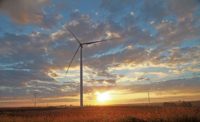There is a renewed interest in construction of high-voltage direct-current transmission lines as they are viewed as an ideal solution to deliver far away wind and solar energy, and to stabilize intermittent renewable power, concepts backed by a recent report prepared for the Energy Information Administration. Although there are few HVDC projects in the United States, Burns & McDonnell is bullish on the technology. “We think the outlook is now more favorable for HVDC as there is no doubt we will see more renewables integrated into our generation portfolio,” says Ken Gerling, the company’s vice president for transmission and distribution.
There was about 106,000 MW of solar and wind in the United States in 2016 and the capacity is expected to grow to about 190,000 MW by 2020, making up about 15% of all installed capacity, according to the EIA report, prepared by ICF International. The share of wind and solar will be even higher in areas such as California, Texas and the Great Plains states, according to the report.
Renewables lead to operational challenges if they produce more electricity than needed or their output falls.
HVDC lines, though, can help smooth the changes in output of individual wind and solar resources by allowing them to be bundled as if they were a single resource, according to ICF. Also, the direction and magnitude of flow over HVDC lines can be controlled, giving grid operators a way to balance the grid during supply-demand imbalances.
Over long distances, HVDC power line technology is less expensive than AC technology, making it ideal for delivering power from remote areas rich in renewable resources to major load centers, according to the report.
“Increased grid interconnection at regional, national, and transnational grid networks would enable more flexibility in power transmission from regions with excess renewable resources to regions with high electricity demand,” ICF said.
Also, HVDC loses up to 40% less power as electricity moves along the power lines than do AC power lines, according to ICF.
Compared with AC lines, which make up the vast majority of transmission lines in the United States, HVDC transmission lines have higher capacity ratings, can handle longer periods of overload operations, can be used underwater and can better manage instabilities that cause blackouts, according to ICF.
According to Gerling, HVDC provides greater power flow control than AC lines through a more compact structure design that includes fewer conductors, smaller towers and poles, fewer right of way requirements and lower cost per mile.
On the downside, converter stations used to convert DC to AC electricity are expensive—ICF pegs their cost at roughly $370 million per station—making shorter projects potentially uneconomic, Gerling said. “This creates other project barriers because long HVDC lines will need to cross multiple states and sometimes Canada and Mexico borders, necessitating regulatory approvals from multiple governing bodies,” he said.
There are only a handful of major HVDC lines in the United States and several underwater cables, according to ICF. There are also more than a dozen HVDC facilities connecting the Eastern and Western interconnections, Texas and Mexico.
The report highlighted several HVDC projects that are under development, including the TransWest Express project, designed to deliver wind from Wyoming to southern Nevada; the Plains & Eastern Clean Line project, which would transport wind from the Oklahoma and Texas panhandles to Arkansas, Tennessee and other states in the region; and the Champlain Hudson Power Express, which would supply the New York City area with hydroelectric power from Canada.
“The resource-rich regions for hydro, wind and solar supply are sometimes hundreds of miles from the population centers that are demanding renewables,” Gerling says, “and our clients are now revisiting the feasibility and operational advantages of transmitting power through HVDC delivery.”





Post a comment to this article
Report Abusive Comment